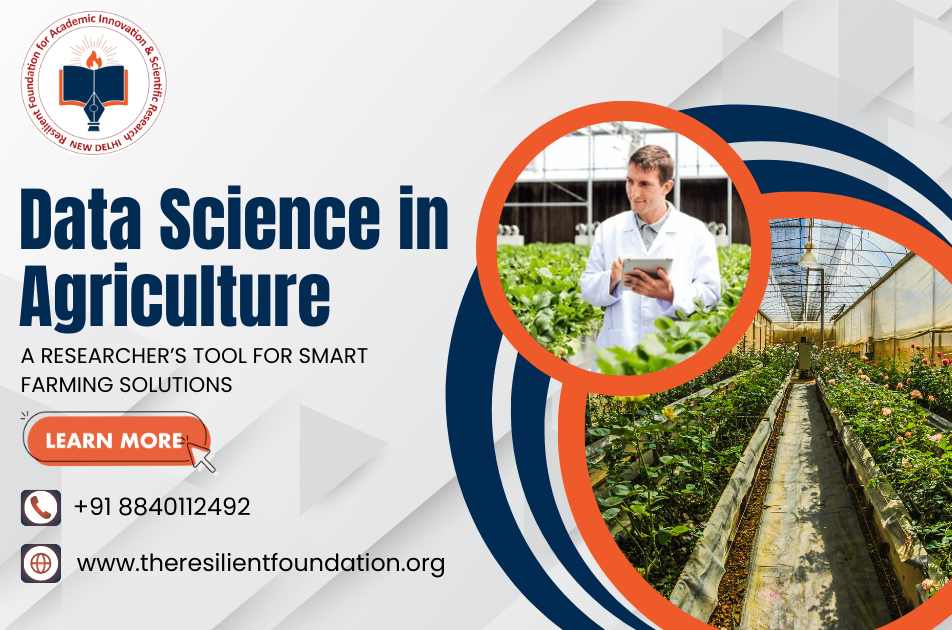Farming has always been about hard work, intuition, and experience. But now, technology is changing the game. Today, data science in agriculture is helping farmers and researchers grow more food with less effort. Because of that, decisions about planting, watering, and harvesting can be made using facts, not guesswork. The Resilient Foundation works closely with experts to make these tools more accessible. In addition, farmers and scientists can now see real-time insights about crops, soil, and weather, helping them solve problems before they grow bigger.
Key Technologies Used in Data Science in Agriculture for Smart Farming
Smart farming is powered by many tools. So, here are the most important ones:

- Remote Sensing and Drones: They take pictures from above, so researchers can check crop health quickly. Thus, this helps improve agricultural predictive analytics by spotting problems early.
- IoT Sensors in Fields: These devices measure soil moisture, temperature, and more. Because of that, farmers can water crops only when needed.
- Geographic Information Systems (GIS): GIS maps show which parts of a field are healthy or struggling. So, treatments can be targeted instead of wasting resources.
- Big Data Platforms: These store and analyse huge amounts of farming information. Also, they help compare trends across seasons.
- Artificial Intelligence (AI): AI predicts future yields and even suggests the best planting schedules.
Resilient Foundation uses these tools in their programs to train researchers and farmers, ensuring no one is left behind in the tech revolution.
How Researchers Use Data Science for Smart Farming?
Researchers are the bridge between technology and farming communities. They use agriculture research training for researchers to master new tools. Here’s how they apply them:

- Analysing Crop Data: By studying growth patterns, they improve yields and quality.
- Studying Soil Health: Testing soil for nutrients helps decide the right fertiliser mix. Thus, this is vital because healthy soil means healthy crops.
- Weather Pattern Tracking: Predicting rain and storms allows better planning.
- Testing New Techniques: With controlled experiments, they find better planting or irrigation methods.
- Sharing Knowledge: Researchers teach farmers how to use these insights for daily work.
The Resilient Foundation plays a big role here because it offers workshops that connect scientific knowledge with real-world farming needs.
Benefits of Data Science in Agriculture
There are many reasons why farmers and researchers are turning to these tools. Here’s why:
- Better Crop Yields: With new research in agriculture, farmers can produce more from the same land.
- Lower Costs: Smart tools cut waste in water, fertiliser, and pesticides.
- Early Problem Detection: Spotting pests or diseases early saves crops.
- Sustainable Farming: Less waste means less harm to the environment.
- Market Predictions: Farmers can choose the best time to sell their produce for higher profits.
Because of these benefits, Resilient Foundation’s training programs are in high demand. Thus, they help small farmers and large agricultural businesses use technology to their advantage.
Expert Tips for Using Data Science in Farming
If you are a researcher or farmer looking to apply data science in agriculture, here are some expert tips:
- Start Small: Begin with one technology, like a soil sensor, before adding more tools.
- Focus on Local Data: Use information from your specific area for accurate agriculture analytics.
- Collaborate with Experts: Work with institutions like the Resilient Foundation for agriculture research training for researchers.
- Keep Learning: Stay updated with the new research in agriculture methods and tools.
- Analyse and Adjust: Use data to make changes quickly if something is not working.
Future Trends in Data Science for Agriculture
Technology is moving fast, and farming will change even more in the next few years. So, here are some trends to watch:
- AI-Driven Farming Robots: Machines will plant, weed, and harvest automatically.
- Blockchain for Food Supply: This will track where food comes from, making it safer for everyone.
- Advanced Climate Models: These will help predict changes and protect crops from extreme weather.
- Genetic Crop Improvement: Data will guide the creation of more resilient plants.
- Smart Market Platforms: Farmers will get better prices using real-time data.
Because the Resilient Foundation stays ahead of these trends, their trainees are always ready for the next big shift in farming. So, this ensures that data science in agriculture stays practical and accessible, even in small communities.

